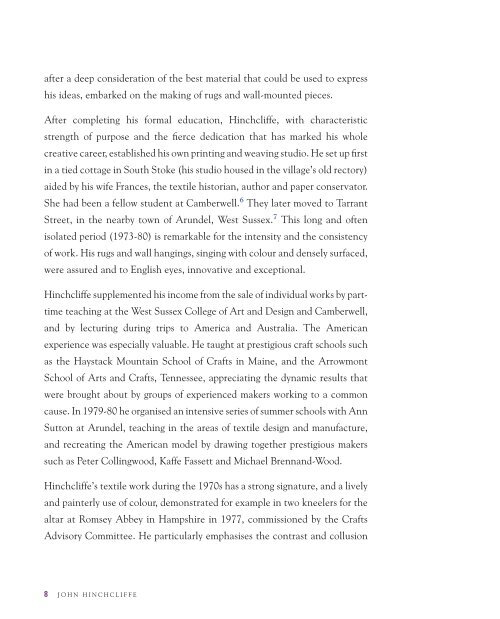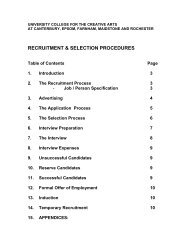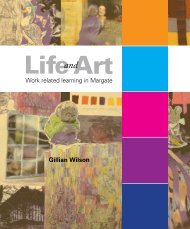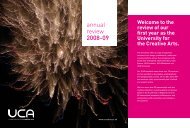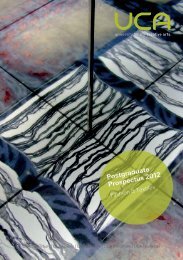John Hinchcliffe
John Hinchcliffe
John Hinchcliffe
- No tags were found...
Create successful ePaper yourself
Turn your PDF publications into a flip-book with our unique Google optimized e-Paper software.
after a deep consideration of the best material that could be used to expresshis ideas, embarked on the making of rugs and wall-mounted pieces.After completing his formal education, <strong>Hinchcliffe</strong>, with characteristicstrength of purpose and the fierce dedication that has marked his wholecreative career, established his own printing and weaving studio. He set up firstin a tied cottage in South Stoke (his studio housed in the village’s old rectory)aided by his wife Frances, the textile historian, author and paper conservator.She had been a fellow student at Camberwell. 6 They later moved to TarrantStreet, in the nearby town of Arundel, West Sussex. 7 This long and oftenisolated period (1973-80) is remarkable for the intensity and the consistencyof work. His rugs and wall hangings, singing with colour and densely surfaced,were assured and to English eyes, innovative and exceptional.<strong>Hinchcliffe</strong> supplemented his income from the sale of individual works by parttimeteaching at the West Sussex College of Art and Design and Camberwell,and by lecturing during trips to America and Australia. The Americanexperience was especially valuable. He taught at prestigious craft schools suchas the Haystack Mountain School of Crafts in Maine, and the ArrowmontSchool of Arts and Crafts, Tennessee, appreciating the dynamic results thatwere brought about by groups of experienced makers working to a commoncause. In 1979-80 he organised an intensive series of summer schools with AnnSutton at Arundel, teaching in the areas of textile design and manufacture,and recreating the American model by drawing together prestigious makerssuch as Peter Collingwood, Kaffe Fassett and Michael Brennand-Wood.<strong>Hinchcliffe</strong>’s textile work during the 1970s has a strong signature, and a livelyand painterly use of colour, demonstrated for example in two kneelers for thealtar at Romsey Abbey in Hampshire in 1977, commissioned by the CraftsAdvisory Committee. He particularly emphasises the contrast and collusionbetween warm and carefully organised batches of coloured materials in rugsand wall hangings. Cloths and wools are used not only for differences orharmonies in colour, but also differences and harmonies in the intrinsicqualities of the materials. His search for materials, purchased directly frommills, scrap cloth merchants or laundries, gives integrity to the whole artisticprocess. This, together with his gathering interest in dyeing, imbues each workwith a strong individual character. Marianne Straub, in her introduction toa Kettle’s Yard touring exhibition in 1981 noted that ‘the dyeing of the yarn,the character and the colours of the materials he uses are as important to himas the techniques of weaving them’. 8But the Arundel studio was a precarious place, as most first studios can be.The celebrated textile artist, confronting another long-term commission for alarge rag rug is bound to face a degree of isolation. There was some consolationin his growing national and international reputation. The ‘craft revival’ ofthe 1970s was a period of impressive developments and opportunities, andan increasing media interest in the crafts. Many of the students in the ‘classof 1973’ at the RCA went on to establish distinguished reputations - AlisonBritton (ceramics) and Fiona Mathison (tapestry and constructions), andSusanna Heron (jewellery), for example. In 1975, <strong>Hinchcliffe</strong> was profiledin Melvyn Bragg’s Second House documentary for BBC2. In 1977 he wonthe Telegraph Sunday Magazine British Craft award in the woven textilescategory (the specialist judge was Peter Collingwood). 9 In the same year hegave a lecture tour in America with funding from the American Craft Counciland the National Endowment for the Arts.<strong>Hinchcliffe</strong> worked mainly to commission in this, his first solo studio. 10Learning the skills of negotiation with a client was to prove invaluable forthe later process of making and selling ceramics. 11 <strong>Hinchcliffe</strong>’s commissions J o h n H i n c h c l i f f e J o h n H i n c h c l i f f e


